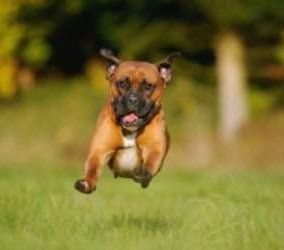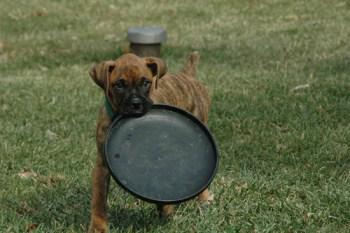Boxer Dog Exercise

Overview
Dogs need plenty of exercise, including the Boxer. This medium breed dog is naturally strong and sturdy; one of the physical qualities that makes this dog so popular. An owner needs to find just the right balance...
A Boxer's exercise needs will change from puppy to adulthood. One must offer enough to keep the dog strong and healthy...
But also know the Boxer's limits....As too much at a young age can hinder proper growth....And too much at certain times can cause health issues.
With this said, a lack of proper exercise over an extended amount of time will lead to muscle loss and weakness in the dog. Boxers under the age of 2 years old have a long way to go in order to mature into muscular, well-built adults. It is not uncommon for Boxer puppies to have loose skin and part of the dog filling out and gaining a tighter coat will be a quality diet and proper physical conditioning.
To keep your Boxer healthy, daily exercise must be provided. Owners must be aware that allowing their dog to roam the yard is not considered to be enough physical activity.
When You Can Start Taking Boxer Pups Outside
While you may want to immediately be able to bring your puppy outside for walks and other exercise, it is important to wait until your Boxer has had his/her 3rd set of shots before going to public places.
Each vet has their own particular schedule; however in general the 3rd and final combination shot (Called a 5-way vaccine) usually includes adenovirus cough and hepatitis, distemper, parainfluenza, and parvovirus.
Some combination vaccines may also include leptospirosis (7-way vaccines) and/or coronavirus) and is given between the age of 12 to 15 weeks. Check with your veterinarian to make sure that "all puppy shots" have been given.
After this time, then you may safely begin to bring your puppy outside to explore the world and to allow him to meet his exercise requirements. Until this time, a puppy should only be allowed outside in an enclosed area, in which there are no other dogs and no chance of other dogs getting into the area.
Consider the Elements
While it is important to exercise your Boxer, keep the weather conditions in mind. The Boxer - along with other Mastiff breeds- have shorter, flatter faces than other dogs. They are a Brachycephalic breed, which means that the skull is compressed.
This physical quality is one that sets the breed apart from others, but also can make breathing difficult in very hot and/or humid or very cold weather. You'll want to follow certain guidelines regarding summer care
when you still need to exercise your Boxer, but it's hot and humid outside.
The shorter hair on a Boxer dog also makes this breed a bit sensitive to outside elements such as extreme sun or cold and rain.
When you walk/jog/play in warm to hot weather with your Boxer dog, be sure to offer plenty of water, but in small amounts at a time. If you will be going for a long hike or walk in bright sunlight, be sure to plan rest stops in shaded areas.
For Boxer dogs that have any white markings, sunscreen should be applied to those areas and to the stomach if you will be out for longer than an hour in bright sunlight. All white Boxer dogs should have sunscreen applied all over (be careful around the face- but do apply to the nose).
What are the Exercise Needs of a Boxer Dog?
Exercise with your Boxer dog should begin slow and increase at a steady pace as your dog grows older and becomes accustomed. Puppies should not be taken on a scheduled walk more than 1 time per day.
This does not mean that he or she needs to say still aside from walk time! This only means that once you have ventured out, a purposeful, brisk walk for a 2nd time may be too much.
Growth plates are not yet fully formed and excessive exercise can impede growth. In addition, muscles are not yet fully formed and cannot handle excessive activity.

Over the course of the 1st year, you can increase exercise with your Boxer, until he or she is meeting the requirements of an adult dog.
A Boxer should have a brisk ( 20 minutes for a puppy, 30 minutes to 45 minutes for an adult) walk each day, given that the temperatures and weather are not extreme. Do not bring your puppy out for walks until all puppy shots are given. If your Boxer enters an adolescent stage from around the 14 to 22 month mark where the Boxer seems too skinny, keep up with exercise and a super-nutritious packed diet as his weight works to catch up to his height.
On very cold days, walks can be kept much shorter. On very hot days, head out in the early morning or later in the evening when it's cooling down. Having 2 walks a day is just fine for adults, especially if you must keep the 1st one of the day shorter than normal. If you keep your Boxer inside and the living quarters are rather small, exercising outside twice per day is best for this breed.
The Boxer dog should be given an opportunity to actually run around for exercise 2-3 times a week. This can be done in a large, fenced yard. If you do not have a yard, finding a large open field is great, as is a controlled environment at a dog park. Naturally athletic, this breed will love to run after a tennis ball and enjoy using all of their muscles.
You can be creative in the type of exercise that you provide to your Boxer dog. This dog can be taught to catch a Frisbee, always fun for both owner and dog. You can train him or her to run along side you as you bicycle, jog or inline skate. This breed, in general, loves to hike alongside their owner...
So any trails or such that you can handle, he or she can as well. Swimming can also be a great way to exercise muscles for both of you.
Best Times for Exercise
Care should be taken to not allow extensive exercise right after the Boxer eats. Exercising your dog immediately after he/she has eaten a large amount of
food can cause digestive problems in the dog or
bloat (also known as Gastric Dilatation Volvulus). This is a canine health condition that can occur from several causes, one being strenuous exercise right after eating.
The symptoms are vomiting (usually dry heaving), a very tight abdomen and restlessness in the dog. This condition needs immediate treatment at an animal hospital or veterinarian. In some cases, this can be fatal to a dog.
Your Boxer will be ready for a walk 1 hour after a meal and for more intense exercise 2 hours after eating. Most do best with activity spaced part; a session in the morning and a session in the evening. If you will be leaving the home for quite a few hours, your dog will behave better if you offer a good burst of exercise before you leave. Try to limit activity within the last hour before expected night time sleep.
Running with a Boxer Dog
You may be a runner and wonder if the Boxer is a good breed to run alongside you.
Dogs with lots of muscle like the Boxer, and especially those that are brachycephalic breeds like the Boxer, do best with short sprints as opposed to long runs. This said, if an owner wants to run with their Boxer, this is something that can be gradually worked on. We'd suggest starting with 2 miles and, similar to a person training for a marathon, work up to a greater distance.
Breaks must be taken for a Boxer to re-hydrate. And of course, if the Boxer starts to appear out of breath, a break must be taken for him to get his breathing under control. While the Boxer is not a severe brachycephalic breed, he is a moderate one. So, those compressed breathing passages can lead to breathing issues if he is over-worked.
